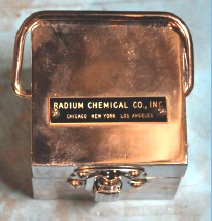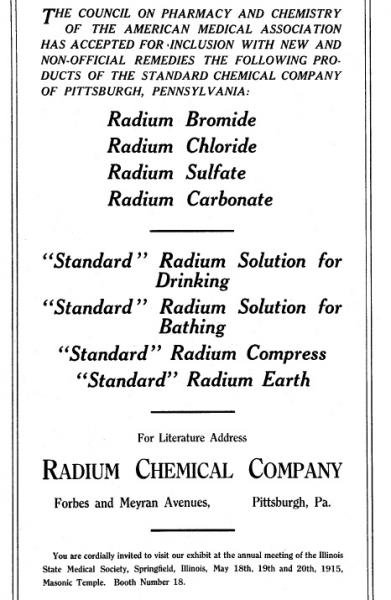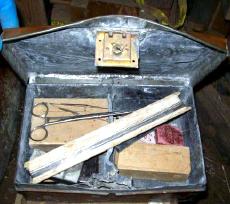
February 2, 2012 – Health and environmental concerns were raised after a radiation detector at a Waste Management Inc. (WMI) facility led to the discovery of an early radiation therapy medical kit someone threw in the trash in Pennsylvania. It contained 1 curie of radium-226, which the Pennsylvania Department of Environmental Protection (DEP) said is equivalent to having more than 100 computed tomography (CT) scans at once.
On Jan. 19, a load of construction debris set off radiation alarms at WMI's Norristown, Pa., transfer station. WMI detained the truck and deployed a health physicist to recover the radioactive material, identified as radium-226. DEP health physicists worked with WMI to properly evaluate and store the radium.
Exposure to this 1 curie of radium-226 has the potential to create skin burns within a few hours of contact, DEP officials said.
"The radioactive material may have been contained in the kit for more than 80 years," said the DEP Bureau of Radiation Protection Director David Allard. "The metal box likely came from a basement, an attic or a collector's stash. Anyone who tampered with it or stored it for a long time may have been exposed to high levels of radiation."
The radium-226 was contained in four capsules inside a small lead safe (known as a “pig”) marked “Radium Chemical Co. Inc.” The safe and some very old equipment were stored inside a larger, locking metal box, which had been pried open. The contents of the box appear to have been medical devices used as long ago as the 1920s. The box had been placed in a dumpster being used by construction workers at the Hershey’s Mill retirement community in West Chester, Pa.
DEP health physicists worked with Waste Management to properly evaluate and store the radium and traced its source to a roll-off container that had come from the Hershey's Mill retirement community in West Chester.
Although the capsules contained in the radium safe are currently being stored at a licensed facility and present no danger to the public, the Department of Environmental Protection has sent out public notices in attempts to find out where and for how long this safe and its radioactive contents were kept prior to Jan. 19, 2012.
"Although the capsules do not appear to be leaking, we believe that someone could have had direct contact with these sources of radium-226," Allard said. "The radioactive radium they contain is about five times the amount found in modern medical sources, and we are concerned about the health of anyone who may have handled them."
Radium was first investigated as a medical treatment for an array of diseases just prior to World War I. The Standard Chemical Company mined radium in Pennsylvania from 1912-1922. It closed due to competition from lower-cost radium that came from the Belgium Congo. The site was later used for the U.S. government's uranium mining operations to supply ore for the Manhattan Project.
To promote the medical uses of radium, Standard Chemical created the subsidiary Radium Chemical Company and produced a medical journal called Radium. The Radium Chemical Company offered numerous ways to deliver radium, including solutions for drinking, bathing, compresses and intravenous delivery. The company created the earliest forms of brachytherapy, producing needles containing radium that were inserted directly into the diseased tissue. The company also produced tubes used for intracavity or superficial therapy. These devices were designed to hold 1, 2, 5 and 10 milligrams of radium-226.
The Radium Chemical Company operated in Queens, N.Y., from the mid-1950s through 1983, where the company leased specially packaged radium to hospitals for use in the treatment of cancer. When it was abandoned, the facility contained a large quantity of radium-226 sealed in small metal tubes or rods, referred to as "needles," totaling approximately 120 curies. In 1983, the state of New York ordered the company to stop its business operations due to a series of regulation violations. State inspections disclosed violations involving lost shipments of needles, radiation levels exceeding allowable standards within the plant, and elevated radon levels, indicating microscopic defects in the needles. In 1987, the state ordered the company to remove its inventory of radioactive sources and to decontaminate the work site. The Environmental Protection Agency completed its cleanup activities at this site in 1995.
Anyone with information about the kit is asked to contact Allard at (717) 787-2480.
For more information: www.dep.state.pa.us
References:
1. R.E. Rowland. “Radium in Humans: A Review of U.S. Studies.” Argonne National Laboratory, September 1994. Accessed online at www.ustur.wsu.edu/Radium/files/RaInHumans.pdf.
2. Joel O. Lubenau. “The Standard Chemical Company, Marie Curie and Canonsburg.” www.canonsburgboro.com/Curie-WebPage/MCurie&StdChemical.htm. Accessed Feb. 2, 2012.
3. “Radium Chemical Company, Inc., New York, EPA ID#: NYD001667872.” U.S. EPA. www.epa.gov/region2/superfund/npl/0202850c.pdf. Accessed Feb. 2, 2012.
4. Oak Ridge Associated Universities. “Radium Chemical Co. Needles and Tubes.” www.orau.org/ptp/collection/brachytherapy/needlestubescase.htm. Accessed Feb. 2, 2012.




 December 11, 2025
December 11, 2025 









